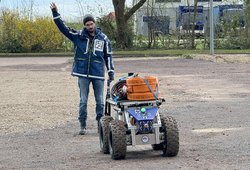ROMATRIS
Robotic material transport in disaster scenarios


The aim of the project is to design and develop a partially automated, mobile assistance robot to support the transportation of materials through rough terrain. The main areas of application are rescue operations in disaster scenarios, such as collapsed buildings, operations in rough terrain, train or traffic accidents and other major emergencies. The system to be developed should be able to follow a person through difficult terrain (gravel, obstacles, inclines), transport the material required for the rescue operation and react to the user's gestures and provide feedback.
| Duration: | 01.09.2021 till 31.08.2025 |
| Donee: | German Research Center for Artificial Intelligence GmbH |
| Sponsor: | Federal Agency for Technical Relief |
| Application Field: | SAR- & Security Robotics |
| Related Robots: |
ASGUARD IV
Advanced Security Guard V4
ARTEMIS
DLR SpaceBot Cup 2013 Rover
|
Project details
The practical suitability of a mobile assistance robot is to be evaluated in a realistic application scenario. In this project, the assistance robot will be developed and built by DFKI and equipped with appropriate control algorithms. Several consecutive field tests are planned for the evaluation on the THW training grounds in Hoya, followed by evaluation and adaptation phases. Particular emphasis will be placed on the robustness of the developed solutions. To this end, the field tests will be carried out with the involvement of experienced THW emergency services personnel. The success of the project will be measured by the system's ability to maneuver at the THW test site in Hoya. There will be very close cooperation with THW personnel during development.
In the future, the system will support civil protection forces during operations in various damage situations and in rough terrain. Currently, heavy materials and equipment are transported by hand to the scene of an emergency. The equipment required also includes heavy objects such as hydraulic rescue equipment or generators, which can weigh more than 50 kilograms. In future, the robot system developed here will be used to move these materials safely through the area of operation in order to reduce the risk of emergency personnel falling.
However, the findings from the scenario described above can also be transferred to other areas of non-police emergency response. For example, a robotic transport system can also provide support in the field of mountain rescue services, where extensive equipment regularly has to be transported through rough terrain. The approach is also interesting for the mine rescue service, as rough terrain, heavy equipment and strenuous activities (work under respiratory protection) are also part of the regular conditions here.
Videos
ROMATRIS: Closing event at the THW training ground in Wesel

THW and DFKI develop innovative robot system for disaster relief operations. After four years of intensive research, the ROMATRIS project has been successfully completed. The German Federal Agency for Technical Relief (THW) and the German Research Center for Artificial Intelligence (DFKI) have developed a novel robot system for material transport. The easy-to-use mobile helper can relieve the burden on emergency services and make operations safer.
ROMATRIS: Participation at the Bremerhaven storm surge exercise with the THW

The DFKI project Romatris was involved as a participant in the Bremerhaven disaster control exercise (scenario - storm surge) on June 15, 2024 with its KRIS robot system. The system is being developed together with the THW and is intended to supplement or improve logistical processes in acute damage situations. The system follows the leading persons on hand signals and can independently drive learned routes at the simple push of a button in order to supplement logistical chains and to relieve the THW emergency services with heavy material in rough terrain.
ROMATRIS: (Partially) autonomous assistance robot for transporting materials in rough terrain

In the event of a disaster, every second counts. To save valuable time and increase the safety of emergency personnel, the DFKI Robotics Innovation Center is developing a (partially) autonomous assistance robot in close cooperation with the German Federal Agency for Technical Relief (THW). The innovative robot is able to follow rescue workers through rough terrain and transport material weighing more than 100 kilograms over uneven terrain. It can react to the gestures of the emergency services and move independently back and forth between two points on a predefined route. The DFKI researchers successfully tested the first version of the system at the THW test and training center in Hoya. The robot transported a 120-kilogram generator, safely crossed railroad tracks and climbed a dike hill. Despite the darkness, it was able to recognize people and respond to their commands. The task now is to implement the feedback from the emergency services and further develop the system accordingly. Once the project has been completed, the robots will soon be put into practical use and help to train emergency services in the use of robotic systems and increase the acceptance of new technologies.

